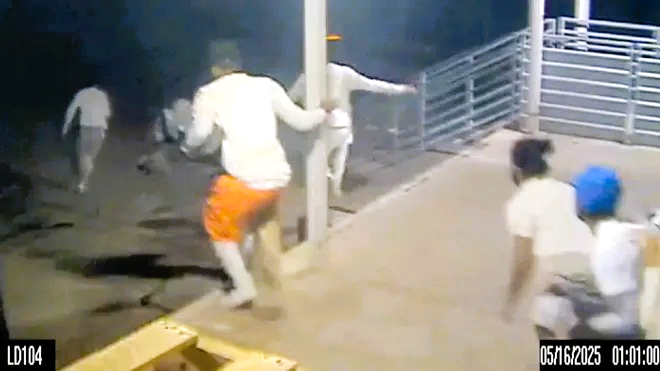Introduction
The effectiveness and legitimacy of correctional systems depend heavily on institutional integrity and secure inmate custody. A breach involving jail staff undermines public confidence and signals systemic weaknesses. On April 27, 2025, a security video from the Orleans Justice Center—New Orleans’ primary detention facility—surfaced, revealing multiple inmates escaping through an unsecured gate, apparently with help from a uniformed correctional officer. The incident triggered a citywide manhunt and intense scrutiny of the Orleans Parish Sheriff’s Office.
Incident Overview
According to the Orleans Parish Sheriff’s Office (2025), the escape occurred during an overnight shift when staff presence was minimal. Surveillance footage released by local authorities shows at least four inmates sprinting from a rear security checkpoint. A corrections officer, later identified as Officer Deandre R. Matthews, is visible in the footage appearing to disengage a security lock and allow the inmates through. Officer Matthews was arrested within hours and charged with assisting escape, malfeasance in office, and obstruction of justice. Three of the escapees were recaptured within 48 hours; one remained at large for nearly a week before being apprehended in Jefferson Parish.
Theoretical Framework: Institutional Betrayal and Correctional Deviance
This case fits within the conceptual model of institutional betrayal, which refers to harm perpetrated by institutions that are trusted to protect and uphold ethical standards (Smith & Freyd, 2013). It also demonstrates correctional deviance, where individuals within the carceral system violate their formal obligations. Scholars such as Clear et al. (2018) argue that these acts are often not isolated but reflect deeper cultural and systemic flaws—i.e., the “rotten barrel” rather than a single “bad apple.”
Systemic Failures and Oversight Gaps
The New Orleans jailbreak exposed several critical weaknesses in the city’s detention infrastructure:
- Understaffing during high-risk shifts: The facility was operating with fewer than half of its scheduled officers during the overnight hours.
- Inadequate supervision and accountability protocols: Internal audits following the incident revealed repeated violations of door security protocol in prior months.
- Lack of surveillance monitoring: Though the escape was recorded, real-time monitoring personnel failed to act in the moment.
These failings align with findings from watchdog reports on systemic deficiencies in Orleans Parish’s jail system, many of which trace back to long-standing underfunding and understaffing (Southern Center for Human Rights, 2024).
Public Response and Political Fallout
The jailbreak quickly escalated into a public safety crisis. The New Orleans Police Department (NOPD), U.S. Marshals, and Louisiana State Police coordinated a citywide search. Mayor LaToya Cantrell condemned the breach and called for a “comprehensive overhaul” of jail operations. Orleans Parish Sheriff Susan Hutson announced an internal investigation and external audit, pledging to cooperate with state and federal authorities.
Simultaneously, state legislators from Orleans and Jefferson Parishes introduced emergency legislation aimed at tightening hiring standards, increasing funding for jail security infrastructure, and requiring third-party oversight in local correctional facilities.
Policy Recommendations
In light of the incident, the following policy reforms are proposed:
- Stronger vetting and continuous screening of correctional officers
- Installation of automated lockdown mechanisms linked to surveillance alerts
- Mandatory ethics and accountability training for all correctional staff
- Creation of an independent correctional oversight board for Orleans Parish
- Enhanced whistleblower protections to report internal misconduct
These recommendations are consistent with broader movements toward criminal justice reform in Louisiana and nationwide.
Conclusion
The Orleans Justice Center jailbreak represents more than a security lapse; it is a failure of institutional accountability. When correctional staff become facilitators of criminal activity, the entire system’s legitimacy is called into question. Preventing such breaches in the future will require a cultural shift within carceral institutions, robust policy enforcement, and renewed public oversight. As New Orleans and the state of Louisiana respond to this crisis, the lessons drawn must translate into durable, systemic change.
References
Clear, T. R., Reisig, M. D., & Cole, G. F. (2018). American corrections (12th ed.). Cengage Learning.
Orleans Parish Sheriff’s Office. (2025, April 28). Press release: Officer arrested in connection with inmate escape from Orleans Justice Center. https://www.opso.us/news
Smith, C. P., & Freyd, J. J. (2013). Dangerous safe havens: Institutional betrayal exacerbates sexual trauma. Journal of Traumatic Stress, 26(1), 119–124. https://doi.org/10.1002/jts.21778
Southern Center for Human Rights. (2024). Orleans Parish: Jail conditions and accountability gaps. https://www.schr.org/reports

By: Donte Nelson


